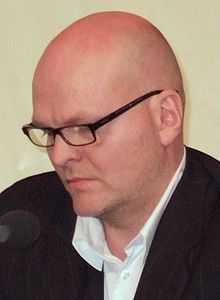Hallgrímur Helgason

Hallgrímur Helgason (born February 18, 1959, Reykjavík) is an Icelandic painter, novelist, translator, and columnist.[1]
Biography
Hallgrímur studied at the Art Academy of Iceland, and then the Academy of Fine Arts in Munich.
He has worked independently as an artist and writer since 1982, and has held over twenty solo exhibitions in Iceland, Boston, Paris and Malmö.[2] His work has also been displayed in over 30 group exhibitions in various countries.
His first novel Hella came out in 1990. His best-known works are 101 Reykjavík, which was made into a popular film of the same name, Höfundur Íslands (The Author of Iceland), which won the Icelandic Literary Prize in 2001, and The Hitman's Guide to House Cleaning. Hallgrímur was also nominated for the Icelandic Prize in 2005 for his novel Rokland. He has also been nominated for the Nordic Council's Literature Prize for both 101 Reykjavík and Rokland. Hallgrímur's novel from 2008, 10 ráð til að hætta að drepa fólk og byrja að vaska upp, was first written in English as The Hitman's Guide to House Cleaning. It was published by Amazon Crossing in January 2012. Only days after publication it reached the top spot on the Amazon Kindle bestsellers list for Thrillers. Helgason's latest novel, "The Woman at 1000°", was published first in Germany in September 2011, by Tropen Verlag, and in Iceland the month after. It was nominated for the Icelandic Literary Prize and the rights has been sold to 12 countries. [3]
He currently lives and works in Reykjavík.
The financial crisis: a 'Baugspenni'?
In 2002, Hallgrímur wrote a prominent article in the main Icelandic daily, Morgunblaðið, supporting Baugur Group and its director Jón Ásgeir Jóhannesson in the 'Baugsmálið', a case brought by the Icelandic state against Baugur, which many, including Hallgrímur, interpreted as part of a personal vendetta by the then prime minister Davíð Oddsson, against Jón Ásgeir.[4] Hallgrímur was moreover at the forefront of developing a new brand for Iceland as a stylish, urbane, and arty destination for tourism and investment, a brand capitalised on by Icelandic financiers including Jón Ásgeir and his wife Ingibjörg Stefanía Pálmadóttir.[5] With the 2008–11 Icelandic financial crisis, however, Hallgrímur faced criticism for his support of Jón Ásgeir, earning him a place among the people accused of being a 'baugspenni' ('Baugur pen').[6] His main response to this was a 2012 article in which he admitted he had made mistakes and concluded that 'sjálfur skal ég glaður heita "Baugspenni" ef það er verðið sem greiða varð fyrir að fá að gagnrýna Davíð Oddsson' ('personally, I will gladly be called a "Baugspenni" if that is the price to pay for getting to criticise Davíð Oddsson').[7] The matter was studied by Alda Björk Vildimarsdóttir and Guðni Elísson; their own conclusion was that criticism had been overstated.[8]
Hallgrímur's more prominent political interventions following the crisis included a number of poems/songs critical of the pre-crisis elites, including Suit and Tie,[9] Ísland er land þitt,[10] and Ég þekki þæga menn.[11] Commentary of this kind was the subject of the parody Riddari niðurrifssins - Hallgrímur Helgason by Ragnar Halldórsson (performed by Eiríkur Örn Norðdahl).[12]
Bibliography
- Óbreyttur maður (A Simple Man, one-act monologue, 1989)
- Hella (1990)
- Þetta er allt að koma (Things Are Going Great, 1994)
- 101 Reykjavík (1996)
- Ljóðmæli 1978-1998 (Collected Poetry 1978-1998, 1998)
- Kossinn: gamanleikur með rómantísku ívafi (The Kiss: a Romantic Comedy, 1999)
- 1000 eyja sósu: eintalsþáttur (Thousand Island Sauce, one-man act, 1999)
- Skáldanótt (Poet's Night, a play in verse, 2000)
- Wake me up before you go go, a musical (2001)
- Höfundur Íslands (The Author of Iceland, 2001)
- Rúm fyrir einn (Single Bed, a short play, 2001)
- Herra alheimur (Mr. Universe, 2003)
- Best of Grim (Cartoons feat. Grim 2004)
- Rokland (Stormland, 2005)
- 10 ráð til að hætta að drepa fólk og byrja að vaska upp (The Hitman's Guide to House Cleaning, 2008)
- Konan sem kyssti of mikið (The Woman Who Kissed Too Much, 2009)
- "Konan við 1000°" (The Woman at 1000°, 2011)
References
- ↑ "...says Hellgrimur Helgason, who writes an outspoken newspaper column which exposes feuds between Iceland's ruling class and its entrepreneurs. He is also the author of 101 Reykjavik, a popular novel populated by 'Krutt-kynslotin' characters." http://www.guardian.co.uk/world/2008/oct/05/iceland.creditcrunch
- ↑ http://www.sagenhaftes-island.is/en/icelandic-literature/authors/nr/236
- ↑ http://hallgrimur.is/hallgrimur/news/
- ↑ Hallgrímur Helgason, 'Baugur og Bláa höndin', Morginblaðið, September 13, 2002, http://www.mbl.is/greinasafn/grein/687538/.
- ↑ Alda Björk Vildimarsdóttir and Guðni Elísson, ' "Og eftir sitjum við með sektarkennd í brjósti": Hallgrímur Helgason og íslenska efnahagshrunið', Ritið: Tímarit Hugvísindastofnunar Háskóla Íslands, 12.2 (2012), 169--9 (pp. 173-74).
- ↑ Alda Björk Vildimarsdóttir and Guðni Elísson, ' "Og eftir sitjum við með sektarkennd í brjósti": Hallgrímur Helgason og íslenska efnahagshrunið', Ritið: Tímarit Hugvísindastofnunar Háskóla Íslands, 12.2 (2012), 169--9 (pp. 173-74). Cf. http://amxtropes.org/pmwiki/pmwiki.php/Main/Baugspenni.
- ↑ Hallgrímur Helgason, 'Draugur Group – minningarorð frá Baugspenna', Tímarit Máls og menningar, 10.2 (2012), http://tmm.forlagid.is/?p=2690.
- ↑ Alda Björk Vildimarsdóttir and Guðni Elísson, ' "Og eftir sitjum við með sektarkennd í brjósti": Hallgrímur Helgason og íslenska efnahagshrunið', Ritið: Tímarit Hugvísindastofnunar Háskóla Íslands, 12.2 (2012), 169--9
- ↑ Video on YouTube
- ↑ Lára Hanna Einarsdóttir, 'Hallgrímur Helga rappar í Kiljunni', Pressan, November 11, 2008, http://blog.eyjan.is/larahanna/2008/11/20/hallgrimur-helga-rappar-i-kiljunni.
- ↑ Tímarit Máls og menningu, 72.1 (2011), 123, http://www.youtube.com/watch?v=prSVBJPPlWo.
- ↑ Video on YouTube
External links
- New Website — Under Construction
- Icelandic literature site on him (English)
- Biographical and bibliographical information
|